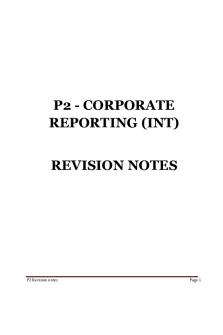P2. Describing motion - Notes for IGCSE Coordinated Sciences PDF

| Title | P2. Describing motion - Notes for IGCSE Coordinated Sciences |
|---|---|
| Course | Coordinated Sciences |
| Institution | Cambridge College |
| Pages | 2 |
| File Size | 53.2 KB |
| File Type | |
| Total Downloads | 69 |
| Total Views | 126 |
Summary
Notes for IGCSE Coordinated Sciences...
Description
*Coordinates to IGCSE Coordinated Sciences SYLLABUS (0645)*
IGCSE - Coordinated Sciences (PHYSICS) STUDY GUIDE - P2 ● ● ● ● ● ● ● ● ● ● ● ●
● ● ● ●
● ● ● ● ● ● ● ● ● ● ● ● ● ●
Speed refers to the distance travelled by an object per unit time. Speed = distance/time Speed relies on the total distance travelled between two points and the total time taken to travel between those. Average speed = total distance/total time Unit for speed is m/s To measure the speed of an object in a lab you use light gates connected to an electronic timer. Light gates beam infrared radiation and when the beam is broken, the timer begins. When the other beam is broken, the timer stops and shows the time taken to travel the distance between both light gates. The interrupt card is what breaks the breams- the faster it is moving, the shorter time it takes to break the beam. Diagram P416 Worked example P418 Distance-time graphs show: graph sloping upwards meaning the object is traveling at a slow speed, graph becomes steeper meaning the object is accelerating, the graph is horizontal means there is no movement/distance is not changing. The steeper the graph, the faster it is going. Acceleration tells us the rate at which its velocity is changing. Deceleration tells us the rate at which its speed is changing- getting slower. Symbol g refers to the force at which an object accelerates free fall, meaning it is being pulled down by gravity. Speed-time graphs tell us how the object’s speed changes AS it moves. The steeper the slope, the greater the acceleration. A negative slope means deceleration. A horizontal slope means a constant speed. Speed at zero means the object has stopped moving. Distance = area under-speed time graph. Worked examples P421/22 Speed = gradient of distance-time graph. Rise/run to find the gradient. Acceleration = change in speed/time taken. Unit for acceleration is m/s^2 (a is used as the symbol). a = v - u/t Worked examples P423/24 Speed-time graphs: acceleration = gradient of speed-time graph.
● ●
Velocity is an object’s particular speed in a particular direction. Acceleration = change in velocity/time taken....
Similar Free PDFs

Coordinated motion function
- 78 Pages

Chapter 2-describing motion
- 26 Pages

Business Studies Notes for Igcse
- 118 Pages

Fanuc R30i B Coordinated Motion Setup
- 189 Pages

ICT Notes for IGCSE ICT 0417
- 97 Pages

P2 notes
- 198 Pages

03 Igcse economics revision notes
- 86 Pages

Plan-Sciences Po - notes
- 1 Pages

Very Condensed Igcse Revision Notes
- 11 Pages

P2 Accowtancy Notes
- 355 Pages

Describing charts
- 8 Pages

Pdfslide - IGCSE
- 83 Pages

Circular Motion - notes
- 10 Pages
Popular Institutions
- Tinajero National High School - Annex
- Politeknik Caltex Riau
- Yokohama City University
- SGT University
- University of Al-Qadisiyah
- Divine Word College of Vigan
- Techniek College Rotterdam
- Universidade de Santiago
- Universiti Teknologi MARA Cawangan Johor Kampus Pasir Gudang
- Poltekkes Kemenkes Yogyakarta
- Baguio City National High School
- Colegio san marcos
- preparatoria uno
- Centro de Bachillerato Tecnológico Industrial y de Servicios No. 107
- Dalian Maritime University
- Quang Trung Secondary School
- Colegio Tecnológico en Informática
- Corporación Regional de Educación Superior
- Grupo CEDVA
- Dar Al Uloom University
- Centro de Estudios Preuniversitarios de la Universidad Nacional de Ingeniería
- 上智大学
- Aakash International School, Nuna Majara
- San Felipe Neri Catholic School
- Kang Chiao International School - New Taipei City
- Misamis Occidental National High School
- Institución Educativa Escuela Normal Juan Ladrilleros
- Kolehiyo ng Pantukan
- Batanes State College
- Instituto Continental
- Sekolah Menengah Kejuruan Kesehatan Kaltara (Tarakan)
- Colegio de La Inmaculada Concepcion - Cebu


